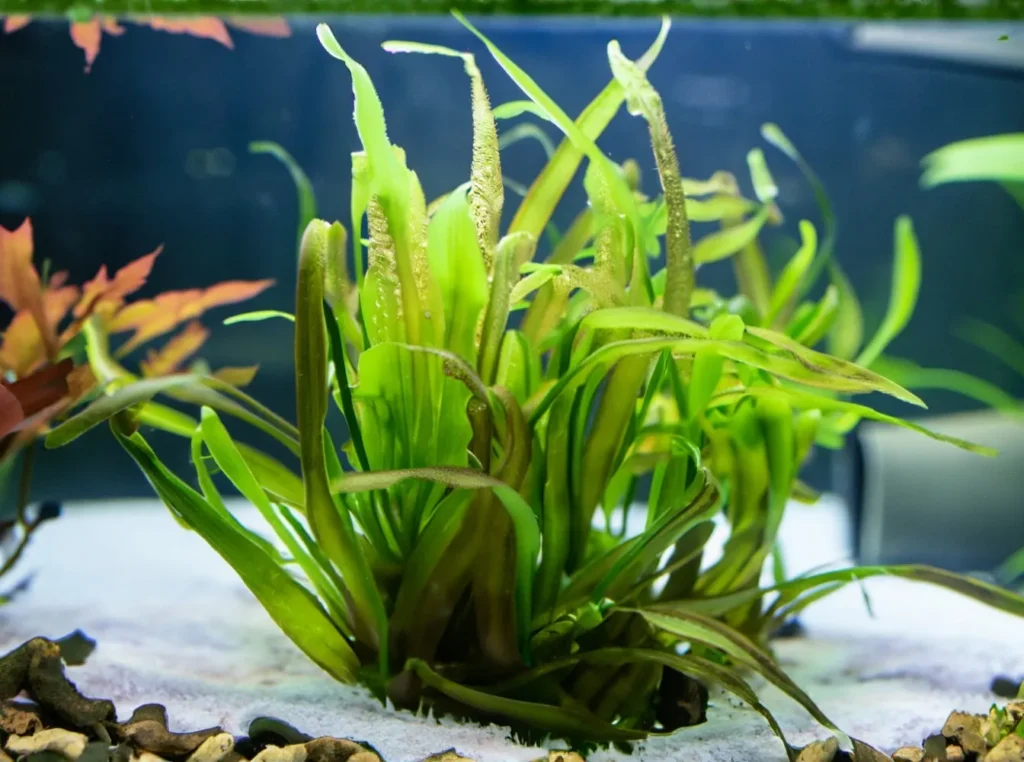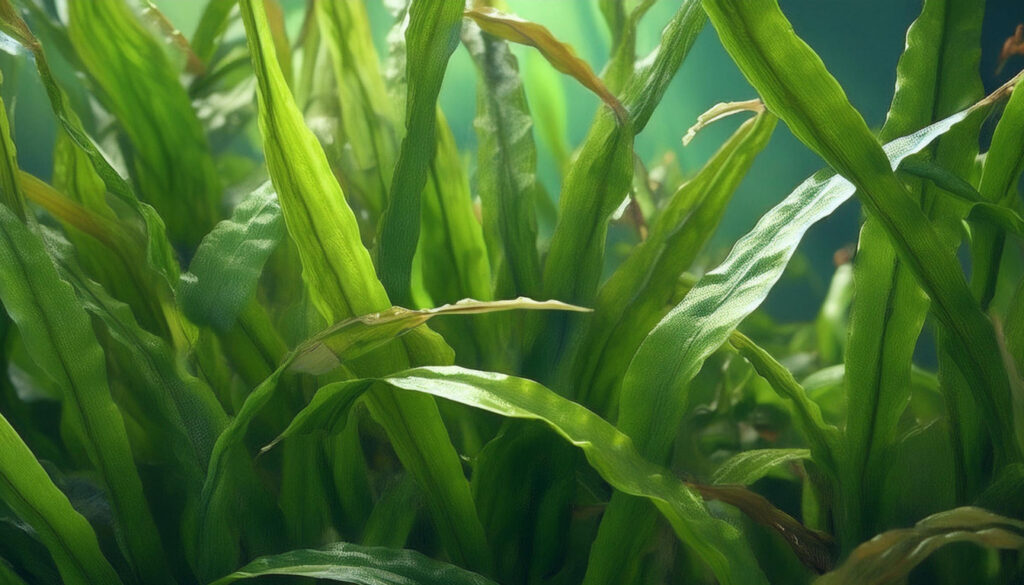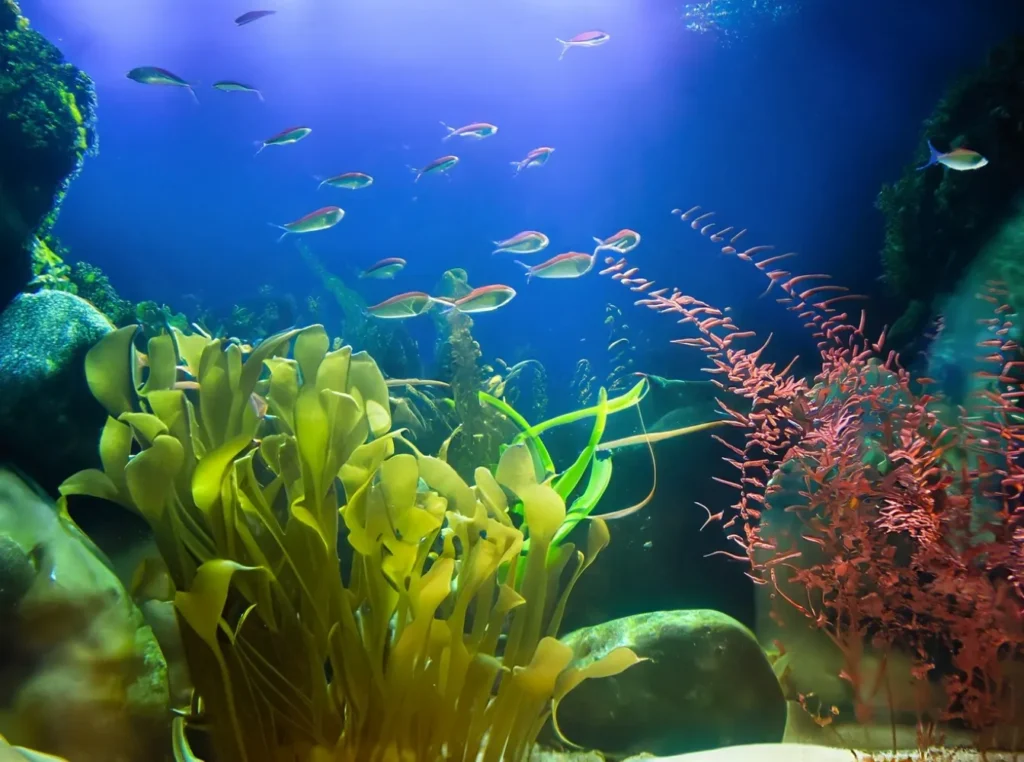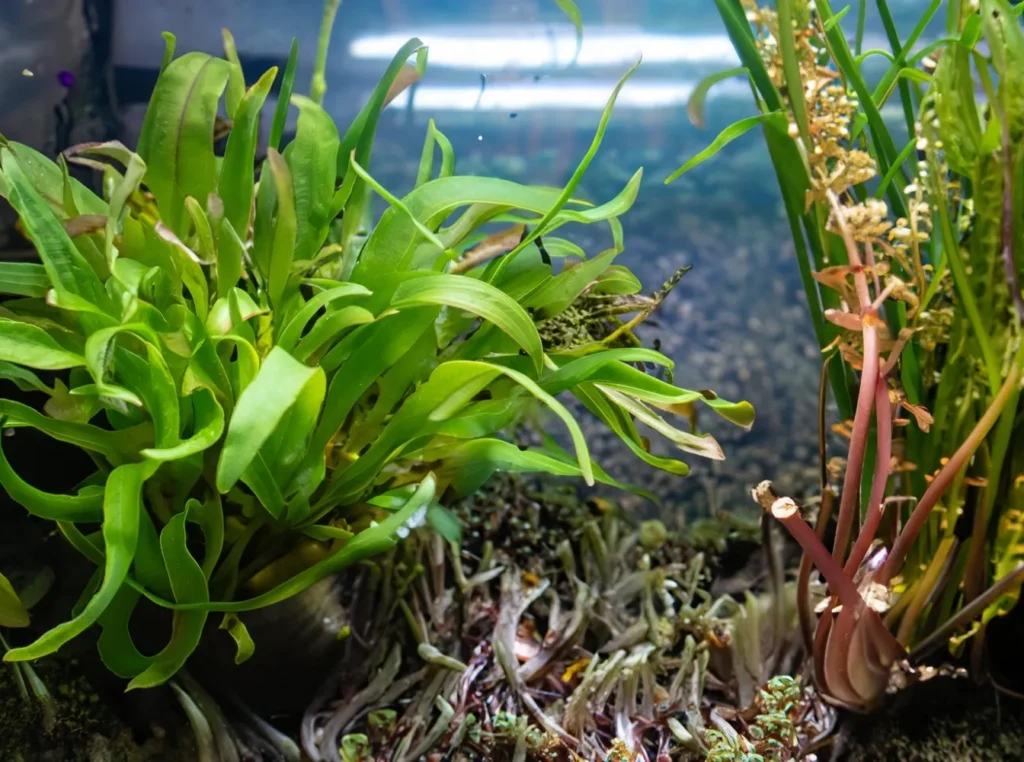Aponogeton Crispus, also known as the Crisp Leaf Aponogeton, is a versatile and beautiful aquatic plant that adds elegance and charm to any freshwater aquarium.
Its unique and attractive foliage makes it a prized addition for aquatic enthusiasts.
In this article, we will explore the natural habitat and origin of Aponogeton Crispus, its physical characteristics, optimal plant growth conditions, and how to incorporate it into a planted tank setup.

We will also discuss the importance of aquatic plant nutrients and the process of propagating Aponogeton Crispus.
Additionally, we will explore other aquarium plant species that can coexist with Aponogeton Crispus and highlight the benefits of having this plant in your aquarium.
By the end of this article, you will have a comprehensive understanding of Aponogeton Crispus and how to care for it in your own aquatic environment.
Key Takeaway
- Aponogeton Crispus is a versatile and beautiful aquatic plant that enhances the aesthetic appeal of freshwater aquariums.
- Understanding the natural habitat and origin of Aponogeton Crispus helps create suitable growth conditions in aquariums.
- Proper lighting, temperature, and water conditions are crucial for the successful growth of Aponogeton Crispus.
- Aponogeton Crispus can be incorporated into a planted tank setup, adding visual interest and creating a thriving aquatic environment.
- Providing the necessary aquatic plant nutrients and understanding the propagation process is essential for the long-term care and cultivation of Aponogeton Crispus.
Quick Stats
| Attribute | Details |
| Family Name | Aponogetonaceae |
| Origin | Sri Lanka |
| Height | 20-50 cm (8-20 inches) |
| pH Range | 6.5 – 7.5 |
| CO2 Requirement | Low |
| Growth Rate | Medium to Fast |
| Care Level | Easy to Medium |
| Color Form | Green, with wavy, translucent leaves |
| Water Conditions | 22-28°C (72-82°F), soft to moderately hard water |
| Max Size | Leaves can grow up to 50 cm (20 inches) long |
| Lighting | Moderate to High |
| Supplements | CO2 is beneficial but not required; macro and micro nutrients |
| Placement | Background |
| Propagation | Bulb division, seeds |
What Is Aponogeton Crispus?
Aponogeton Crispus is a species of aquatic plant commonly used in aquariums. It originates from Madagascar and is characterized by its long, narrow leaves with a crinkled or wavy appearance.
Aponogeton Crispus is known for its distinctive reddish-brown coloration, which can vary depending on the lighting conditions and nutrient levels in the aquarium.
This plant typically grows to a height of 20-40 cm (8-16 inches) and requires moderate to high lighting to thrive. It is relatively undemanding in terms of care and can be propagated through bulb division.
Aponogeton Crispus adds visual interest and texture to aquarium layouts, making it a popular choice among aquarists.

The Natural Habitat and Origin
Aponogeton Crispus, also known as the Crisp Leaf Aponogeton, is a stunning aquatic plant that is native to Sri Lanka, Madagascar, and Indo-China.
It thrives in freshwater habitats such as rivers, streams, and ponds, contributing to the vibrant ecosystem.
Understanding the natural habitat and origin of Aponogeton Crispus is crucial for recreating suitable conditions in our aquariums and ensuring the well-being of this beautiful plant.
To visualize its natural habitat, take a moment to admire the image below:

“Aponogeton Crispus beautifully thrives in the serene freshwater habitats of Sri Lanka, Madagascar, and Indo-China, adding elegance to these natural ecosystems.”
Aponogeton Crispus, as part of the Aponogetonaceae family, has adapted to the specific water conditions found in its native environment.
We can ensure that our Aponogeton Crispus plants flourish by replicating these conditions in our aquariums.
This includes providing suitable water parameters, temperature ranges, and nutrient levels to support their growth and overall health.
RELATED: Aquascaping With Anubias Barteri For A Creative Aquascape
Physical Characteristics Of Aponogeton Crispus
Aponogeton Crispus is a versatile aquatic plant with unique physical characteristics that distinguish it from other plants in its family.
Its wavy-edged leaves exhibit vibrant colors ranging from green to red, creating a visually stunning display in any freshwater aquarium.
Understanding the physical features of Aponogeton Crispus is crucial for aquarists to identify and appreciate its beauty and versatility.
The leaves of Aponogeton Crispus are notable for their elegant shape and texture. They are typically broad, elongated, and slightly curved, showcasing the plant’s graceful nature.
The wavy edges of the leaves add depth and dimension to its appearance, enhancing its aesthetic appeal in the aquarium setting.
Aponogeton Crispus exhibits remarkable color variations, which further contribute to its allure.
The leaves can range from vibrant shades of green, reminiscent of lush foliage, to captivating hues of red, which intensify the visual impact of the plant.
These color variations offer aquarists the opportunity to create unique and captivating aquascapes.

The physical characteristics of Aponogeton Crispus make it a versatile and visually captivating addition to any freshwater aquarium.
Its wavy-edged leaves and vibrant color variations create a striking focal point, elevating the aesthetic appeal of the aquatic environment.
Lighting Demands For Lush Foliage
- Aponogeton Crispus requires adequate lighting to develop lush foliage. Providing light’s right intensity and duration is crucial for its photosynthesis and overall growth.
- Ideally, the aquarium should have moderate to high lighting levels, simulating the plant’s natural habitat.
- LED or fluorescent aquarium plant lighting can ensure that Aponogeton Crispus receives the necessary light to thrive and showcase its vibrant foliage.
RELATED: The Hardy Bacopa Monnieri (Moneywort) That Thrives Almost Anywhere
Temperature Parameters For Robust Health
- Maintaining suitable temperature parameters is vital for the robust health of Aponogeton Crispus. This aquatic plant prefers water temperatures between 72°F and 82°F (22°C and 28°C).
- It is important to avoid extreme temperature fluctuations, as they can stress the plant and hinder its growth.
- By providing a stable and consistent temperature range within the recommended parameters, aquarists can ensure optimal conditions for Aponogeton Crispus to flourish.
Water Conditions For Optimal Growth
- Aponogeton Crispus thrives in well-maintained water conditions. It prefers slightly acidic to neutral pH levels, ranging from 6.5 to 7.5, and moderately hard water with a general hardness (GH) between 4 to 8 dGH.
- Adequate water circulation and filtration are also essential to maintain water quality and prevent the accumulation of toxins.
- Additionally, regular water changes and the use of liquid or substrate fertilizers with essential micronutrients can help provide the necessary nutrients for optimal growth.
| Lighting Demands | Temperature Parameters | Water Conditions |
| Requires moderate to high lighting levels | Optimal temperature range: 72°F – 82°F (22°C – 28°C) | pH levels: 6.5 – 7.5; GH: 4 – 8 dGH |
| LED or fluorescent aquarium plant lighting recommended | Stable and consistent temperature range | Water circulation and filtration for water quality |
| Avoid extreme temperature fluctuations | Regular water changes and nutrient supplementation |
Substrate Requirements
- When setting up your tank with Aponogeton Crispus, it is essential to choose a suitable substrate. This plant thrives in nutrient-rich substrates that provide the necessary elements for its growth.
- Consider using a fine-grained substrate, such as a nutrient-rich soil or aquatic plant-specific substrate, to promote healthy root development. The substrate should be deep enough to anchor the plant’s roots firmly.
Placement Options
- Choosing the appropriate placement for Aponogeton Crispus is crucial to creating a visually appealing layout. This plant is best showcased as a centerpiece or positioned in the background of the aquarium.
- Its tall and vibrant leaves create a stunning vertical element in the tank. Placing Aponogeton Crispus towards the back corners or sides of the tank allows it to grow freely while maintaining balance and harmony with other aquatic plants.
Recommended Tank Size
- Consider the size of your tank when incorporating Aponogeton Crispus. This plant can grow quite large, with leaves extending above the water’s surface.
- To ensure proper growth and prevent overcrowding, it is recommended to have a tank with a capacity of at least 20 gallons (75 liters) for accommodating Aponogeton Crispus.
Suitable Tank Mates For Aponogeton Crispus
- Aponogeton Crispus can coexist harmoniously with a variety of tank mates in a planted aquarium. However, selecting compatible species that thrive under similar water conditions is important.
- Some suitable tank mates for Aponogeton Crispus include Java Fern (Microsorum pteropus), Anubias (Anubias spp.), and Amazon Sword (Echinodorus spp.).
- These plants complement Aponogeton Crispus nicely and create a visually diverse and appealing aquarium.

The Essentials Of Aquatic Plant Maintenance
Maintaining the optimal nutrient balance is key to Aponogeton Crispus’s growth and overall well-being. The plant relies on macronutrients and micronutrients.
Macronutrients
- Nitrogen (N): Aponogeton Crispus requires an adequate supply of nitrogen for healthy leaf and root development.
- Phosphorus (P): Phosphorus is essential for promoting root growth and ensuring active metabolism in Aponogeton Crispus.
- Potassium (K): Potassium plays a crucial role in maintaining proper cellular functions and promoting overall plant health.
Micronutrients
- Iron (Fe): Iron is vital for chlorophyll production and photosynthesis in Aponogeton Crispus.
- Zinc (Zn): Zinc is necessary for enzyme function and overall growth.
- Manganese (Mn): Manganese supports chlorophyll synthesis and aids in the breakdown of carbohydrates.
Regular fertilization is crucial to ensure that Aponogeton Crispus receives the necessary nutrients. Various types of fertilizers are available specifically formulated for aquatic plants.
Choosing a quality fertilizer that meets the nutritional needs of Aponogeton Crispus will help promote healthy growth and vibrant foliage.

The Essentials Of Aquatic Plant Maintenance
In addition to providing the necessary nutrients, there are other essential aspects of aquatic plant maintenance that contribute to the overall health and appearance of Aponogeton Crispus.
- Pruning: Regularly trimming and removing dead or decaying leaves and stems will promote healthy growth and prevent the accumulation of waste in your aquarium.
- Monitoring Lighting: Aponogeton Crispus requires moderate to high lighting conditions to thrive. Ensure your aquarium provides appropriate lighting intensity and duration to support optimal photosynthesis and growth.
- Water Circulation: Proper water circulation helps distribute nutrients evenly throughout the aquarium, ensuring that Aponogeton Crispus receives the essential elements it needs for healthy growth.
- Coexistence: Consider the compatibility of it with other aquatic plant species and ensure that they have similar lighting and water requirements. This will help maintain a harmonious and balanced ecosystem in your aquarium.
Cultivation
Aponogeton Crispus, with its exquisite beauty, can be cultivated successfully in aquariums, allowing aquarists to enjoy its elegant presence in their aquatic environments.
Cultivating this aquatic plant involves several essential steps that ensure its successful growth and establishment.
Following the guidelines outlined below, you can confidently cultivate Aponogeton Crispus and appreciate its captivating beauty in your aquarium.
Preparing For Growth
To begin the cultivation process, it is crucial to prepare the plant for growth. Start by selecting a healthy Aponogeton Crispus specimen from a reliable source, ensuring that it is free from any signs of disease or damage.
Once obtained, carefully remove the plant from its packaging, keeping the roots intact.

- Next, prepare the aquarium by providing suitable water conditions and substrate. Aponogeton Crispus thrives in slightly acidic to neutral water with a pH range of 6.5 to 7.5.
- Maintain a water temperature of 72°F to 82°F (22°C to 28°C). Ensure an appropriate substrate, such as nutrient-rich aquarium soil or sand, to support the plant’s root system.
Planting And Initial Care
- When planting Aponogeton Crispus, gently insert the roots into the substrate, burying them at a depth of approximately 2 to 4 inches (5 to 10 cm). Be cautious not to damage the delicate roots during this process.
- Once planted, ensure that the substrate securely covers the roots and that the plant’s crown is positioned just above the surface.
- After planting, provide ample lighting for the plant’s development. Aponogeton Crispus requires moderate to high levels of light to flourish.
- Use aquatic plant-specific LED lights or fluorescent lights with a spectrum suitable for plant growth. Maintain a lighting period of 8 to 10 hours daily to support photosynthesis.
- Monitoring and maintaining water quality parameters such as ammonia, nitrite, and nitrate levels is essential.
- Regular water changes, nutrient dosing, and the use of a quality aquarium filtration system will help maintain a stable and healthy environment for Aponogeton Crispus to thrive.
Continued Maintenance
- As this plant grows, ensure regular pruning to maintain its desired shape and prevent overcrowding. Remove any dead or decaying leaves promptly to promote healthy growth.
- Nutrient supplementation is also vital to support the plant’s nutritional needs. Use a balanced liquid fertilizer with essential macronutrients and micronutrients as directed, providing the necessary nourishment for optimal growth.
- Regularly observe the overall health and appearance of it, as it can indicate any potential issues or imbalances in the aquarium. Adjust care routines or water parameters as necessary to ensure the ongoing vitality of the plant.
RELATED: The Aquatic Wonder Bacopa Australis To Transform Your Aquascape
The Pre-germination Process
- The pre-germination process is an essential step in preparing Aponogeton Crispus for propagation. To begin, carefully collect ripe seeds from the plant’s flowers or seed pods.
- Place the seeds in a small container of distilled water and allow them to soak for 24 to 48 hours. This soaking process softens the seed coat and promotes quicker germination.
- After the seeds have soaked, transfer them to a tray or dish filled with a suitable aquatic planting medium, such as a mix of sand and aquatic plant substrate. Gently press the seeds into the substrate, leaving a small portion exposed to light.
- Maintain a water temperature of around 75 to 80°F (24 to 27°C) and provide adequate lighting to support germination.
- You should see small shoots emerging from the seeds within a few weeks. At this stage, you can transfer the young plants to their permanent location in the aquarium.
Plant Propagation Tips
Successfully propagating Aponogeton Crispus requires attention to detail and proper care. Here are some essential plant propagation tips to help you achieve the best results:
- Ensure your aquarium has suitable water conditions, such as a pH level of 6.8 to 7.5 and moderate water hardness.
- Provide ample lighting for the plants, using high-quality aquarium plant lights that offer the appropriate intensity and spectrum.
- Regularly monitor and maintain the water temperature between 75 to 80°F (24 to 27°C) for optimum growth.
- Fertilize the plants regularly with a balanced aquarium plant fertilizer to provide essential nutrients for healthy growth.
- Prune and remove any dead or decaying leaves to maintain the overall health and appearance of the plants.
| Propagation Tips for Aponogeton Crispus | Pre-germination Process |
| Ensure suitable water conditions | Collect ripe seeds and soak in distilled water |
| Provide adequate lighting | Transfer soaked seeds to aquatic planting medium |
| Maintain optimal water temperature | Allow seeds to germinate and sprout |
| Fertilize regularly | Transfer young plants to permanent location |
| Prune and remove dead leaves |
Exploring Aquarium Plant Species: Neighbors Of Aponogeton Crispus
Aponogeton Crispus can coexist harmoniously with a variety of aquarium plant species. By diversifying the plant population in your aquarium, you can create a visually appealing and ecologically balanced aquatic environment.
Let’s explore some plant species that make excellent companions for Aponogeton Crispus.
“The presence of compatible plant species in the aquarium not only enhances the overall aesthetic appeal but also provides natural habitats and hiding spots for fish and other aquatic creatures.”
When selecting plant species to accompany Aponogeton Crispus, it is important to consider factors such as lighting requirements, water conditions, and growth habits.
By choosing plants that have similar needs, you can ensure their successful coexistence and create a visually cohesive aquascape.
Some popular aquarium plant species that pair well with this plantinclude:
- Anubias Barteri: This plant has broad and durable leaves, making it an excellent choice for low-light environments. It thrives in the same water conditions as Aponogeton Crispus, making it an ideal companion.
- Hemianthus Callitrichoides: Commonly known as Dwarf Baby Tears, this plant adds a lush carpet effect to the aquarium. It requires high levels of light and carbon dioxide supplementation, making it compatible with Aponogeton Crispus in a well-lit environment.
- Echinodorus Amazonicus: With its large, vibrant green leaves, this plant creates a stunning background focal point in the aquarium. It grows well in a variety of water conditions, making it a versatile companion for Aponogeton Crispus.
Benefits
- Incorporating It into your aquarium setup offers numerous benefits that will enhance both the aesthetic appeal and overall health of your tank.
- First and foremost, the lush foliage of it adds a touch of natural beauty to any aquarium. Its wavy-edged leaves, which can vary in color from green to red, create a visually stunning underwater landscape that will captivate your attention.
- Not only does Aponogeton Crispus contribute to the visual aesthetics of your aquarium, but it also improves the water quality. This plant acts as a natural filter, absorbing excess nutrients and reducing the risk of algae growth. By incorporating it, you are providing a healthier environment for your fish and other aquatic creatures.
- Furthermore, it provides natural habitats and hiding spots for fish. Its dense foliage and sturdy stems create shelter and refuge for your aquatic pets, mimicking their natural habitat and reducing stress levels. This is especially important for shy or territorial fish species.
- By understanding and embracing the benefits of Aponogeton Crispus, you can create a thriving and visually appealing aquarium that promotes the well-being of your aquatic inhabitants.
Conclusion
Aponogeton Crispus is a versatile and beautiful aquatic plant that adds elegance and charm to any freshwater aquarium.
This plant, belonging to the Aponogetonaceae family, is native to Sri Lanka, Madagascar, and Indo-China.
Aquarists can ensure its thriving presence in aquariums by recreating the ideal growth conditions for Aponogeton Crispus, including appropriate lighting, temperature parameters, and water conditions.
Overall, It offers numerous benefits, including enhancing the aesthetic appeal of the aquarium, improving water quality, and providing natural habitats for aquatic creatures.
Aquarists can create visually stunning and flourishing aquatic landscapes by incorporating this versatile plant into their aquatic environments.
Frequently Asked Questions
How Can I Induce And Manage The Dormancy Period In Aponogeton Crispus To Ensure Its Long-Term Health And Vigor?
This plant naturally goes through dormancy periods, especially when water temperatures rise. To induce dormancy artificially, gradually increase the aquarium temperature over several weeks. Then, reduce lighting and stop fertilization to mimic natural conditions.
You can remove the bulb from the tank and store it in damp aquarium substrate or sand in a cool, dark place for 2-3 months.
Reintroduce the bulb to the aquarium by gradually adjusting it back to standard conditions to end the dormancy period. Managing this cycle can help rejuvenate the plant and encourage robust growth when active.
What Specific Lighting Conditions Optimize The Growth And Leaf Coloration Of Aponogeton Crispus?
It thrives under moderate to high lighting conditions. While it can grow in lower light, brighter light encourages more vigorous growth and enhances the crinkled texture and translucency of the leaves.
If using high-intensity lighting, ensure that the plant also receives adequate nutrients to support its increased growth rate. However, be mindful of placing it under excessively strong light for extended periods, as this can lead to algae growth on the leaves.
Can Aponogeton Crispus Be Propagated, And If So, What Methods Are Most Effective?
It can be propagated primarily through seed production or by dividing the tuber, if it naturally splits. The plant may produce flowers that, if pollinated (even self-pollinated in some cases), can develop seeds. Once seeds are produced, they can be harvested and sown in a fine substrate under shallow water or moist conditions until germination.
Propagation by dividing the tuber is less common but possible if the tuber naturally divides; each section must have at least one growth point to develop into a new plant.
How Does Water Hardness And Ph Affect The Growth Of Aponogeton Crispus, And What Are The Ideal Conditions?
It is adaptable to a range of water hardness and pH levels but prefers slightly acidic to slightly alkaline water (pH 6.5-7.5) and moderate hardness (5-15 dGH). These conditions mimic its natural habitat and promote healthy growth.
While it can tolerate variations, extreme conditions may inhibit growth or lead to poor health. Regular water testing and adjustments, if necessary, can ensure the plant thrives.
What Advanced Nutrient Supplementation Strategies Benefit Aponogeton Crispus The Most?
While it absorb nutrients from the water column, its growth and health greatly benefit from a nutrient-rich substrate or the addition of root tabs. Given its rapid growth when active, a balanced supply of macro (N, P, K) and micro nutrients, especially iron, is essential for maintaining vibrant, healthy foliage.
In tanks with CO2 supplementation and high lighting, increased nutrient dosing may be necessary to match the plant’s growth demands. Regularly monitor nutrient levels and adjust dosing as needed to prevent deficiencies or excesses that can lead to algae growth.
- Unveiling The Wonders Of Riccia Fluitans In Aquascapes - August 7, 2024
- Vallisneria Gigantea Var. Guide To Care And Cultivation At Home - July 31, 2024
- Vesicularia Dubyana Care & Growth Guide Tips For Beginner Gardeners - July 30, 2024
